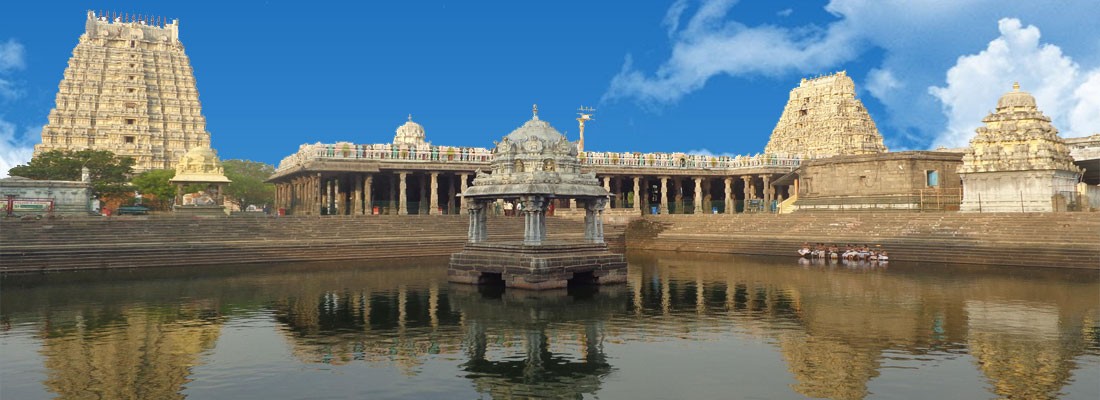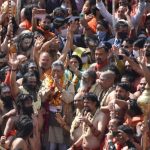This is the Second in the five part Shiva series of articles that will be published in this week of Sravana Month – Ekambareswarar temple.
The Ekambareswarar temple located in Kanchipuram (Kanchi), Tamilnadu is one of the most ancient temples in India. The presiding deity here is Shiva as Ekambareswarar and is represented as Lingam. It is one of the Pancha Bhoota Stal where the Lord Shiva is worshipped as Prithvi Lingam and is said to be created by Goddess Parvati.
The temple is the largest temple in the town of Kanchipuram and is located in the northern part of the town. The temple is said to be in existence since 600 AD and is built by Chola Kings. It has a mango tree that is more than 3500 years old and till date gives four varieties of mangoes and this is said to symbolize the four Vedas.

Legend
The legend says that, once while Shiva was meditating Parvati playfully covered his eyes with her fingers which resulted in complete darkness on the earth for several years, angered by Parvati’s act Shiva curses her. Parvati realizing her mistake comes to earth to penance come to Kanchipuram and creates the earth linga and worships beneath a mango tree.
Another story relating to the Ekambareswarar Temple is that while Goddess Parvati was meditating under the Mango tree, the neighboring Vegavati river overflew and threatened to engulf the Prithvi Lingam. In order to protect the lingam, Goddess Parvati embraced it. Pleased by her devotion, Shiva appeared before her and married Parvathi. This gave him the name, “Tazhuva kuzhainthaar” meaning “he who melted in her embrace” in Tamil.

History
This vast temple is one of the most ancient in India having been in existence since 600 AD. Second century AD Tamil poetry speaks of Kama kottam, and the Kumara kottam (currently the Kamakashi Amman temple and the Subramanya temple). Initially temple was built by the Pallavas and Vedantist Kachiyapper served as a priest at the temple. Later Cholas pulled down the temple and built the existing structure. It is said that Adi Sankara, the 10th-century saint got Kanchipuram remodelled along with the expansion of this temple along with Kamakshi temple and Varadaraja Perumal Temple with the help of local rulers.
The Vijayanagar kings 15th century has made lots of contributions to the temple. Later it was developed by Vallal Pachiyappa Mudaliar, who used to visit the temple regularly from Chennai to Kanchipuram. He spent a significant amount of money during British rule on the temple renovation. Pachiyappa Mudaliar can be seen on a temple pillar as seated on a horse back.
Must Read
Shiva Temple Series : Kalahasthi -The Power of Vayu
Temple
The temple gopuram (gateway tower) is 59m tall, which is one of the tallest gopurams in India. One of the notable features of the temple is the Aayiram Kaal Mandapam (hallway with a thousand pillars), which was built by the Vijayanagar Kings. The temple’s inner walls are decorated with an array of 1,008 Siva lingams. The Temple is built in 25 acres with 5 prakarams (courtyards) and has a thousand-pillared hall. Kampai Tirtha, the temple tank is believed to have an underground holy river. The fourth courtyard contains a small Ganesha temple and a pond. The third courtyard contains lot of smaller shrines. The sanctum Sanctorum contains the linguine along with the image of Shiva.

There is no separate shrine for Parvati within the complex as with other Shiva temples in Kanchipuram. A local belief is that Goddess Kamakshi Temple is the consort for Ekambareswar. There is a small shrine for Vishnu worshipped as Vamana Murthy and the shrine is hailed by the Alvar saints as one of the 108 Divya Desams.
There is a huge Mango Tree in the temple tree which is said to be 3,500-year-old. It is said that it is under this tree that Parvathi has meditated. The mango tree branches are said to yield four different types of mangoes from its four branches, depicting the four Vedas.

A unique feature of the temple is that, the sun rays fall directly on the main shivalinga on every 19, 20 and 21 of Phalguni months (March-April).
Another architectural marvel in the Temple is that, in the inner corridor there are 10 pillars producing different musical sounds when tapped them with a stick.
There is a Kubera idol in the temple and devotees believe that he grants riches to his worshippers.
But the most most unique features to the Ekambareswarar Temple is the 12 zodiac signs on the roof of the temple. It is believed by many people that when prayed to their specific zodiac sign at the temple one can get rid of horoscopes defects (Jatakadosha).
Festivals

The Panguni Uthiram festival celebrated during the month of March–April is the most popular of all the temple festivals in Kanchipuram.
Must Read Significance of Rudrabhishek in the month of Shravan









